Review: Truth, Beauty, and a Picture of You, Hayes Theatre
Over at the Lyric, a new Australian, Sydney-set musical is telling the story of a family legacy, of art and love. It’s Strictly Ballroom; you’ve probably heard of it. In Potts Point, in a much smaller theatre, on a set allergic to glitz and sparkle, there’s a new Australian, Sydney-set musical telling a story of love, family and art, but that’s where the similarities end. Where Strictly smooths over character bumps and blemishes, Truth, Beauty, and a Picture of You isn’t into cosmetics: it wants to heal those who are broken.
Truth, Beauty, and a Picture of You is Hayes Theatre Co.’s first new Australian musical in their ground-breaking first year as a company devoted to fostering musical theatre and cabaret in Australia. It’s the flip-side of Strictly Ballroom. It’s the gritty inner-west, pub rock and guitars and VB in the daytime. It’s a world where the dream has already faded and the band has broken up. The glory days are gone.
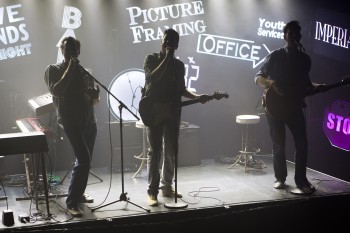
Enter Tom (Ross Chisari), son of Stewie, late front man of the band in question. He’s down from Taree to meet his father’s bandmates and try to connect in some way with someone who is, of course, hugely important to Tom, even though he died before he was born. What he finds instead is the ruination of men past their prime, who walk full-time with ghosts.
Anton (Ian Stenlake), the band’s pianist, is a mess of a human: dishevelled, out of shape, hair sticking up in a mockery of a halo, hopeless and meandering, sleeping his way through life. Charlie (Scott Irwin) is even more lost, clinging to the promise of a temporary rush at his favourite poker machine, isolated from the world at large.
Tom’s sense of wide-eyed, hopeful adventure, needless to say, fades fast. He ventures into the city, holding tightly to the hand of a girl, Beatrice (Erica Lovell), he found on the platform of Newtown Station. She thinks Tom is cute – “Country cute. Manly cute.” – but romance seems a bit too much to ask, so instead she shows him around the city, gets him drunk, and forces Anton to let the boy into his life.
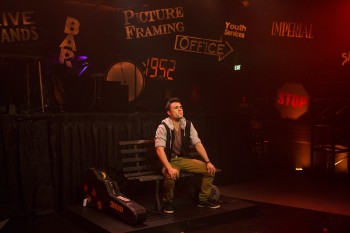
It’s a pleasant experience to watch Chisari take Tom on a journey into a more realistic life view, where men are flawed and people are complex and no one is an angel, saint, or above reproach because they were once famous on three blocks in Newtown. His polite, mannered voice, a little affected and Disney, takes a more robust sound as we delve further into the story. Tom’s no rock god yet, but he’s only 20. He barely knows who he is yet. He spends the whole play carrying around a guitar, but, tellingly, we never see him play; when called on it by Beatrice, he angrily tells her it’s not his guitar – it’s his dad’s.
The more compelling story, however, takes past both in the past – when the band was still a band and Stewie (Toby Francis) was still alive – and in the future, where Anton and Charlie don’t even bother trying to put their lives together anymore. Stenlake shines as Anton, a talent who has long denied himself an outlet for it. Soon after meeting Tom, he sits at his piano for the first time in a long time and plays an inspired, fits-and-starts take on “No Aphrodisiac” that builds into a cri de coeur of sorts, yearning and frustrated and defiantly clever, suddenly a tumble of words and soul. Something in him, long dormant, wakes up.
Stenlake is the heart of the show, despite the entire character of Tom being our introduction into this world and our ostensible protagonist, and part of this is because Anton is gifted with the songs in the Tim Freedman oeuvre that require the most heart and commitment and grant the greatest emotional connection. While “Charlie No. 2” comes too early in the show for us to really participate in its grief (we have literally only just met Charlie), “Blow up the Pokies” lands perfectly, settled into the second act.
Irwin has less vocal heavy lifting as Charlie, but he lifts his acting game for this production considerably. His leading-man looks are stamped out by the weight of twenty years of disappointment and bad hairstyling; he stoops slightly, bent by despair. He’s the most broken person on stage but still manages to inject life into the place this show needs it most: the book.
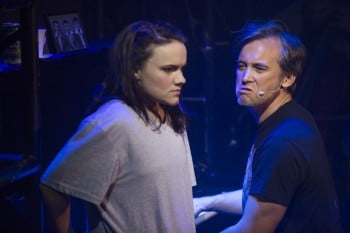
It improves by the second act, but for the first, the book is a stuttering distraction killing time between excellent musical numbers; Tom and Beatrice’s meet-cute is stilted and clichéd (it does try to be ironic, but its own self-awareness doesn’t excuse its re-tread of every alternative teen romance film of the early 2000s) and the dialogue is too pointed. There’s a lot of exposition to get through in a brand new story, but it’s too heavy-handed here.
When the show lives in the past, the book relaxes and the characters relax. Francis (in possession of a rock tenor that deserves more attention than it gets), Stenlake and Irwin have excellent chemistry, and their muso ease and camaraderie livens up the Hayes. Their language relaxes and they interact with each other without delicacy or regard for personal space. Stenlake and Irwin carry this bond into their scenes in the present, saving several other scenes from a clunky death – a drunk scene in the second act as the two men struggle to find their way home is far more successful, funny, and surprisingly emotional than most of the rest of the show.
Sometimes, when a jukebox musical attempts an original story, rather than a biography of the source band or musician, the songs feel jammed into the plot like an ill-fitting puzzle piece (think the bewildering Ben Elton misfire of We Will Rock You). Here, the story makes sense. The soul of Freedman is on every King Street corner; musical director Andrew Worboys plays us into a scene change with “God Drinks at the Botany View (Now the Sando’s Changed Its Name)”. It’s all Thai restaurants, Petersham, and The Imperial. Beatrice lives “under the planes” in St Peters. With the Whitlams heart that has always beaten inner west bars and decrying how pub culture turned into destruction, of course we’re visiting this old band, invented for this show but like so many others we know, ingrained in our cultural consciousness.
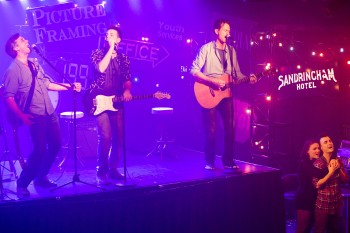
It might have been to the show’s benefit to spend more time in the past. It may even have benefited from moving the requisite love story (a strong, classical musical theatre move – explore bigger issues and life stories with an anchoring love story in the middle – it’s something Rodgers and Hammerstein perfected half a century ago) from the present into the past. We needed one; there’s too much love in Freedman’s words and there’s too much raw feeling in this musical to not have an outlet somewhere, and Lovell’s voice as love interest brings a sonorous sweetness to Freedman’s straight-talking honest lyrics.
Most impressive are the musical numbers, already tried and tested for quality through the four-platinum-album success of Tim Freedman’s The Whitlams. Narrative-driven, many of the songs are perfect character sketches in themselves; it makes sense that this body of work would become a musical. When we start in the past with a blistering “You Sound Like Louis Burdett” with those defiant-excited keys and those brash but impossibly smart lyrics, it’s happened: the audience has been drawn into the world of the show.
A retractable platform stage (set design by James Browne) lets a good portion of the music happen above our heads, slightly out-of-reach, slightly unreal. When the songs happen on our level, they’re happening now, and they’re revealing something about the characters. Tom and Beatrice “Fall For You” inches from the feet of the first row attendees. Anton and Charlie aren’t above anyone, or the world, when they’re singing about buying now and paying later. It’s a subtle storytelling choice, but it’s one of the better ones.
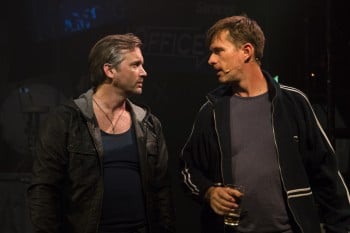
Strictly Ballroom is going to get attention and column inches for days; it’s an idealised version of the artist’s dream. Even the Coke sign in the Cross looks artistic. It has a budget and it has Baz. However, a healthy musical theatre cultural needs to operate at all levels; shows in a small theatre in Potts Point need to be developed, nurtured and discussed so they don’t disappear into the ether. By staging new work on a small-scale, independent level, Hayes Theatre Co is presenting writers, artists and performers to the wider world; they are building Australian stories in a country that sees so many revivals and imports of international works. To have a new independent Australian musical play at the same time as a new main stage Australian musical is exciting. When the sector is healthy, it’s devising and staging at all levels.
And, honestly, Truth, Beauty, and a Picture of You is a more satisfying theatrical experience than Strictly, even if it’s Sando sign retains also the grimy unremarkable non-charm of the original: its pacing is more or less on point, its musical numbers are all successes, and it understands how to use musical motifs to bridge and transition scenes and moments.
It’s also a more down-to-earth, arguably more relatable story that provides an alternative to people looking for a new musical experience (and the considerably less expensive ticket price doesn’t hurt, either).
Hayes Theatre Co should be commended for demonstrating their commitment to new Australian musicals by putting a brand-new piece in the first half of their first year of operation. They picked a good show, too: Truth, Beauty, and a Picture of You isn’t perfect, but it’s good, it’s strong, its music never disappoints, and it showcases deeply Australian characters and storytelling. You probably never knew how much you needed it in your musical theatregoing experiences until you saw it, but it’s a kind of like a long exhale: it’s okay, we’re creating, we’re here.

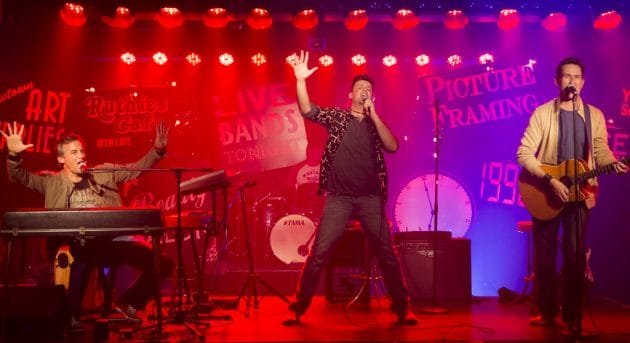
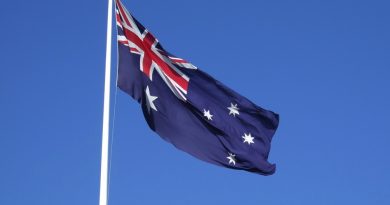

Very good and honest review.
Great review for a musical theatre savvy audience.
I’m seeing it tomorrow and hope to be challenged much more than I hope to see a plastic show.